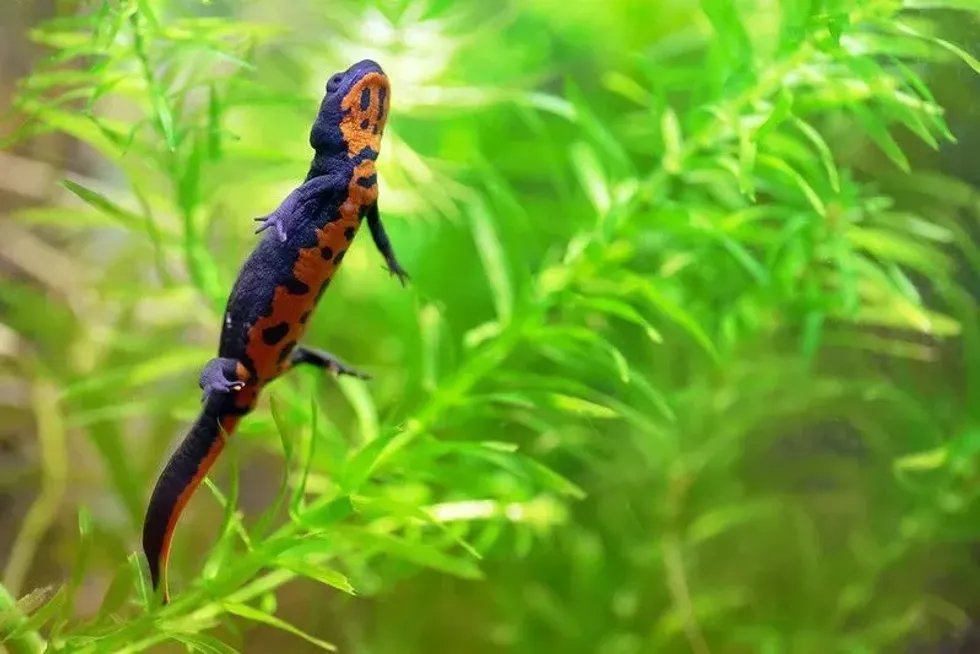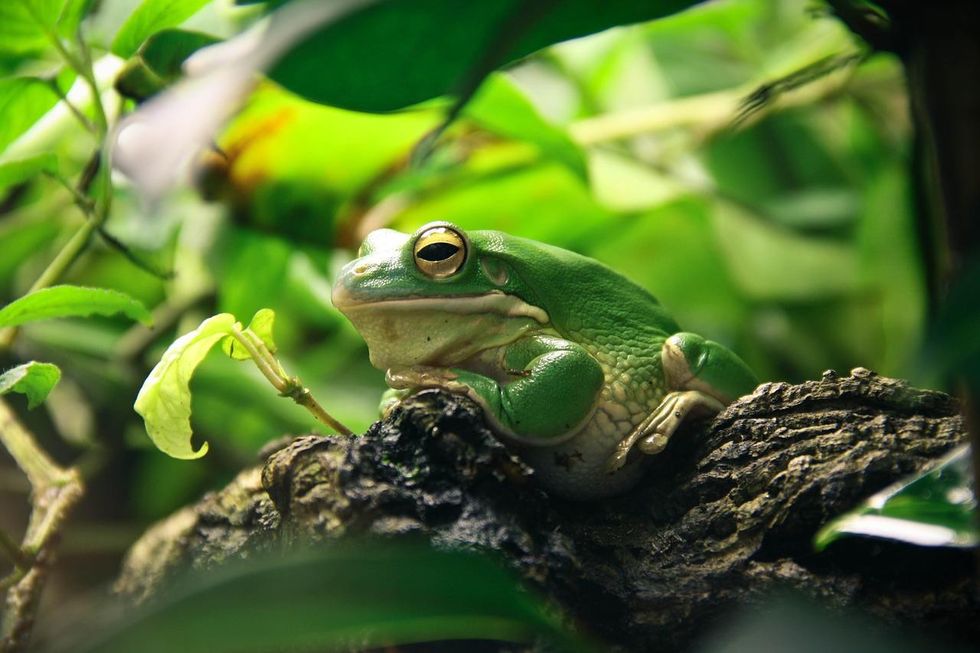Belonging to the Salamandridae family and genus Cynops, a fire-bellied newt is an amphibian. The scientific name of fire belly newt is Cynops pyrrhogaster.
They are also called Chinese fire belly newt (Cynops orientalis), Oriental Fire-Belly newt, and Japanese fire-belly newt. Cynops orientalis is a very popular species of newts that can reach up to 4 in (10 cm).
These semi-aquatic species are also found in pet stores in aquarium, hence there are many people who prefer to keep them as their pet. They eat various food items of both plant and animal matter, and also freeze-dried items.
Dechlorinated water is used to fill up the aquatic portion of the enclosure.
It is better to have a big enclosure or tank as it becomes easy to clean it and less enclosure waste gets collected. Water filtration is very important for the health of the tank in which these newts live.
Fire Belly Newt Interesting Facts
What type of animal is a fire belly newt?
The fire belly newt (Cynops pyrrhogaster) is a type of newt which is the salamander in the subfamily Pleurodelinae. The fire belly newt is a lively, robust creature with simple care instructions.
For new amphibian keepers, they are a popular option. Fire belly newts are beautiful pets because of their bright orange-red patterns on their stomachs, and they only need a tiny enclosure that simulates their natural habitat.
What class of animal does a fire belly newt belong to?
These newts belong to the phylum Chordata, Amphibia class, and order Urodela. Some of the most popular amphibians offered as pets are the Chinese fire belly newt (Cynops orientalis) (also known as the oriental fire belly newt) and the Japanese fire belly newt.
The Chinese fire belly newt can be found in the wild in China at low and moderate elevations near slow-moving bodies of water, while the Japanese fire belly newt can be found in similar settings across Japan.
How many fire belly newts are there in the world?
The exact number of fire belly newts is not known yet.
Cool temperatures are ideal for fire belly newts. They withstand a wide range of temperatures but prefer temperatures between 62 - 68 F (16-20 C).
Fire belly newts can get stressed and prone to infection, especially fungal infection, as the temperatures changes and goes above 75 F (23 C).
Maintaining appropriate temperatures in your newt's tank might be as simple as keeping it in the basement. In warmer weather, a fan over the tank or a supply of melting dechlorinated ice might assist your newt to cool down if the room temperature rises too high.
Where does a fire belly newt live?
Zhejiang, Anhui, Jiangsu, Jiangxi, and Hubei are some provinces in China that are a good habitat for these species.
Suitable water sources at various altitudes, Mountain ponds, flooded fields, small brooks, wells, cold still ponds, terraced fields, and ditches are good places to thrive well.
When the water is icy and quiet, under the shadow of grass, with a muddy bottom clear of stones, and the creatures often swim back to the top, darting back and forth actively, according to early researchers.
Despite the fact that this knowledge is minimal, it provides clear guidance on how to retain this species in captivity.
What is a fire belly newt's habitat?
The fire belly newt must be housed in an aquarium that closely resembles its natural habitat. Because fire-belly newts are aquatic, they require a plentiful supply of water. They also require an arid land area in the tank where they may jump out of the waters and relax while basking in artificial sunlight.
Up to five Fire-Belly Newts can be housed in a 20-gallon (91 l) tank. However, the larger the enclosure, the more easily it can be kept clean. It's easier to cope with waste buildup when there's more water.
When constructing the aquarium's land area, use a gravel substrate to create a sloping area. Aquatic substrate for this species might be anything from naked glass to aquarium gravel concealing a filtration system to Java moss.
They're not going to be finicky about the water's substrate. To provide wonderful hiding spots for the fire-belly newt, add java moss, rocks, and pieces of bark. A floating island made of wood or rocks is also an option.
Who do fire belly newts live with?
The fire belly newts need to live with four to five fire belly newts if they are in an aquarium. Other than that, in their natural surroundings, they are generally found in small groups. Competition for food is not there between these aquatic creatures in an aquarium.
How long does a fire belly newt live?
Japanese fire-bellied newts live for a long time. The typical lifespan is roughly 25 years with good care. There are other records of people who have lived for up to 45 years.
How do they reproduce?
C. pyrrhogaster breeds in the wild from early spring to the start of June, with April being the busiest month. Several hundreds of eggs are laid after courting, each individually packaged in aquatic plant leaves.
After about 20 days, the larvae hatch. For the greatest productivity, larvae should be raised individually. Freshly hatched brine shrimp, daphnia, artemia, and infusoria must be offered often throughout the day.
After three to four months, the newt undergoes metamorphosis and enters the terrestrial stage. At this stage, the young are around 1.5 -1.7 in (40-45 mm) long.
What is their conservation status?
The conservation status of this species varies according to the type. Some are Near Threatened, while others are Least Concern.
Fire Belly Newt Fun Facts
What do fire belly newts look like?
A little newt has a dark brown to the black upper body and an orange to crimson belly with many black markings. There may also be little orange dots on the dorsum, especially on the upper side of the limbs.
Some people have a slight orange to brownish dorsal stripe. C. orientalis possesses conspicuous parotoid glands and rather smooth skin.
Males are thinner and lighter overall as compared to the females and are likely to be squarish in cross-section as compared with the larger, rounder females. Males have shorter tails with somewhat higher tail fins, indicating sexual dimorphism in the tail.

How cute are they?
They are very small, but they are not cute. Though they have a good color combination of orange and black, they might look colorful but are not appealing.
They eat various food items of both plant and animal matter, and also freeze-dried items. Dechlorinated water is used to fill up the aquatic portion of the enclosure.
Maintaining appropriate temperatures in your newt's tank might be as simple as keeping it in the basement. In warmer weather, a fan over the tank or a supply of melting dechlorinated ice might assist your newt to cool down if the room temperature rises too high.
How do they communicate?
Visual and chemical cues are the primary means through which newts communicate. Newts do, however, focus on low sounds, but very little is known about that. Their sounds are scarcely discernible, yet they do communicate verbally.
How big is a fire belly newt?
Fire-belly newts are creatures of water but like to spend some items outside water at a terrestrial habitat as well. They reach a height of 3-5 in (7-12 cm). The largest newt is the Great-crested newt, which is only found in Europe, and female fire belly newt can grow to be 7 in (17 cm) long.
How fast can a Fire Belly Newt move?
They move slowly on land but swim quickly. A fire belly newts might run at a pace of 30 mph (48 kph) on land. They are prey to a variety of species, including snakes like garters, even birds and predatory fish. The kids must also be wary of the adults because cannibalism is widespread.
How much does a fire belly newt weigh?
Fire-belly newts can be around 0.3-1.8 oz (8-51 g).
What are the male and female names of the species?
No specific names are given to the male and female of this species of newts.
What would you call a baby fire belly newt?
There is no specific name given to the young one, they are simply called 'baby fire belly newt'. They are also called Larvae. Some other species of newt are called Tadpoles.
Tadpoles are newt offspring that hatch from eggs. When it matures into a terrestrial newt, it is referred to as an eft. When larvae hatch from eggs, they go through metamorphosis and grow their limbs to be an eft.
What do they eat?
Bloodworms, glass shrimp, daphnia, brine shrimp, and freeze-dried Tubifex cubes are some food items that should be fed to fire-belly newts. Floating amphibian sticks and guppies are also a good option for food items.
It takes some trial and error to determine how much and how frequently your Fire-belly newt consumes. Every day now or every two to three days is usually sufficient if you are feeding them freeze-dried matter.
Keep an eye on your newt's bodily condition to see if you're providing it too much or too little. Excess food in the fire belly newt tank is an indication that you're feeding your newt too frequently, and rotting food will lead to toxic accumulation in the tank.
Are they poisonous?
These amphibians are harmful to a lesser extent and release toxins via their skin. This poison is the same as that found in pufferfish, and it is responsible for the hospitalization of hundreds of imprudent gourmets each year after devouring 'fugu' or globefish.
Would they make a good pet?
As these amphibians emit toxins from their skin, they are not a good pet to have and are not recommended as a pet if there are little children in the house. The toxin is irritating to adults' undamaged skin, but it might be fatal to a young child who gets it in their mouth.
Even adults who approach this animal with fresh cuts, scratches, or sores on their hands may experience dizziness, numbness, and shortness of breath.
As a result, this is an aesthetically appealing pet only. In wild, they protect themselves through this mechanism.
Did You Know...
A different species of this amphibian called the Japanese fire-bellied newt may regenerate its own eye lenses numerous times.
Different Types of Fire Belly Newt
There are different types of fire belly newts species like the Chenggong fire belly newt, Chuxiong fire-bellied newt or blue-tailed fire belly newt, Japanese sword-tail newt, Fuding fire belly newt, Chinese fire belly newt (Cynops Orientalis), Dayang newt or Dayang fire belly newt, Japanese fire belly newt, and Yunnan lake newt.
They are generally found in the countries of Japan and China.
How well can fire belly newts see?
There is not much information available on this but the newts who have bright eyes have good eyesight.










